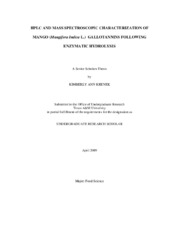| dc.description.abstract | Mangos contain numerous compounds that have been shown to exhibit antioxidant
properties. These compounds, most of which are polyphenolics, are linked to anti-cancer
and anti-inflammatory activities in the body. Mangos more specifically boast a large
number of high molecular weight compounds called gallotannins, composed of gallic
acid units attached to glucose via a glycosidic linkage. It is unknown if these compounds
are broken down into smaller molecules through the normal course of human digestion,
or if food processing operations, such as the addition of a gallotannin-active hydrolyases,
could be more effective in lowering the size of these molecules to increase the
absorption and potential bioactivity. This research focused on understanding the
chemical changes that occur to gallotannins derived from mangos following enzymatic
hydrolysis and attempted to draw inferences relating to overall human health.
Polyphenolics in mangos, cv. Ataulfo were extracted using a 1:1:1
acetone:ethanol:methanol mixture and further concentrated and clarified using a reverseiv
phase C18 Sep-Pak cartridge. Mango extracts were treated with 20,000 U/ml and
13,000U/ml B-glucosidase with a time course of 2, 4, 6, and 8 hours in an optimal pH 5.0
citric acid buffer, and at a constant temperature of 35 C. Changes in mango
polyphenolics following enzyme hydrolysis were monitored using a Thermo Finnigan
LCQ Deca XP Max MSn ion trap mass spectrometer equipped with an ESI ion source.
B-glucosidase proved to be effective in the hydrolysis of some gallotannins but was
incapable of hydrolyzing all gallotannins into free gallic acid. This was illustrated by the
observance of an increase in penta, hexa, hepta-O- and a subsequent decrease in higher
molecular weight compounds. The limitations for complete hydrolysis explains by the
inability of B-glucosidase to cleave the glycosidic linkage due to steric hindrance created
from having up to five gallic acid moieties attached to glucose, or from the inability of
the enzyme to break m-dipside linkages between two or more galloyl groups. Incubating
mango extract with both 20,000 U/mL and 13,000 U/mL resulted in an equivalent eightfold
increase in free gallic acid. Enzyme concentration was not the limiting factor in the
hydrolytic reaction. Additionally, reaction time did not have a significant role in the
hydrolytic rate, as the amount of free gallic remained relatively constant from 2 to 8
hours. These findings indicated that it was possible to increase low molecular weight
gallotannin species following enzyme hydrolysis and will aid in future studies to
understand the digestion and bioavailability mango phenolics. | en |


